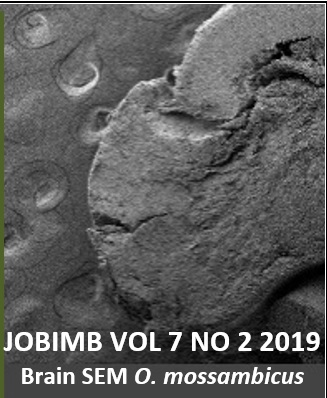Efficacy of Different Marination Methods on Microbial Quality of Meat
DOI:
https://doi.org/10.54987/jobimb.v7i2.481Keywords:
microbiological count; marinade; Sodium dodecyl sulfate; DMSO; antimicrobialAbstract
Beef meat is an animal flesh food that is considered a good diet for consumption as it contains many minerals, vitamins, basic amino acids and essential fatty acids. The people prefer marinated beef meat from a few decades. Microbiological count affection food and especially pathogenic organisms of public health importance. The tenderness and flavour considered as the main factors that affect consumer’s acceptability and satisfaction. World’s beef meat production in 2016 is approximately about 321,000,000 tons. The importance of post marinated beef meat on quality and acceptability with the importance of consumer point of view as the health and diet increases as beef meat is a high source of minerals, protein, vitamins as well as some essential compounds. Samples from meat food were collected from supermarkets, Egypt. This study evaluates the effects of marinade on meat microbial quality as reduction of the microbiological count. Microbial count was carried out by using selective medium and to determine the best marinating method. The results indicated that SDS+1% give best microbial controlling buffer where decreasing bacterial and fungal count to around zero that gave marvellous results.
References
Sipahi C. Turkiye’de entansif hindi yetiştiriciliği. Vet HekimLer Derneği Derg. 2006;77(4):17–21.
Iseri Ö. Hindi etinin beslenmedeki yeri ve önemi. Vet Tavukçuluk Dernegi Derg. 2007;5(4):1–4.
Stadelman WJ, Olson VM, Shemwell GA, Pasch S. Nutritional value of poultry meat. In: Morton ID, Scott R, Watson DH, Lewis MG, editors. Egg and poultry- meat processing. Chichester: Ellis Horwood; 1988. p. 92–122.
Masiero L. Nutritional qualities of turkey meat. World Poult Misset. 1993;9:42–3.
Gök V, Kayaardi S, Obuz E. Extending the Chilled Shelf Life of Vacuum-Packaged Ground Beef Using Ascorbic Acid, Nitrite or Salt. J Muscle Foods. 2009;20(2):211–26.
He F-Y, Kim H-W, Hwang K-E, Song D-H, Kim Y-J, Ham Y-K, et al. Effect of Ginger Extract and Citric Acid on the Tenderness of Duck Breast Muscles. Korean J Food Sci Anim Resour. 2015;35(6):721–30.
Fu Y, Young JF, Therkildsen M. Bioactive peptides in beef: Endogenous generation through postmortem aging. Meat Sci. 2017 Jan 1;123:134–42.
Iida F, Miyazaki Y, Tsuyuki R, Kato K, Egusa A, Ogoshi H, et al. Changes in taste compounds, breaking properties, and sensory attributes during dry aging of beef from Japanese black cattle. Meat Sci. 2016 Feb 1;112:46–51.
Monsón F, Sañudo C, Sierra I. Influence of breed and ageing time on the sensory meat quality and consumer acceptability in intensively reared beef. Meat Sci. 2005 Nov 1;71(3):471–9.
Ismail HA, Lee EJ, Ko KY, Ahn DU. Effects of aging time and natural antioxidants on the color, lipid oxidation and volatiles of irradiated ground beef. Meat Sci. 2008 Nov 1;80(3):582–91.
Lawrence TE, Dikeman ME, Hunt MC, Kastner CL, Johnson DE. Staged injection marination with calcium lactate, phosphate and salt may improve beef water-binding ability and palatability traits. Meat Sci. 2003 Nov;65(3):967–72.
Burke RM, Monahan FJ. The tenderisation of shin beef using a citrus juice marinade. Meat Sci. 2003 Feb 1;63(2):161–8.
Anang DM, Rusul G, Bakar J, Ling FH. Effects of lactic acid and lauricidin on the survival of Listeria monocytogenes, Salmonella enteritidis and Escherichia coli O157:H7 in chicken breast stored at 4°C. Food Control. 2007 Aug 1;18(8):961–9.
Żochowska-Kujawska J, Lachowicz K, Sobczak M. Effects of fibre type and kefir, wine lemon, and pineapple marinades on texture and sensory properties of wild boar and deer longissimus muscle. Meat Sci. 2012 Dec 1;92(4):675–80.
Tokifuji A, Matsushima Y, Hachisuka K, Yoshioka K. Texture, sensory and swallowing characteristics of high-pressure-heat-treated pork meat gel as a dysphagia diet. Meat Sci. 2013 Apr 1;93(4):843–8.
Lytou AE, Panagou EZ, Nychas G-JE. Effect of different marinating conditions on the evolution of spoilage microbiota and metabolomic profile of chicken breast fillets. Food Microbiol. 2017 Sep 1;66:141–9.
Ministry of Food and Drug Safety White Paper 2013. Osong, Korea: Ministry of Food and Drug Safety; 2013. (Korean food code).
Mani-López E, GarcÃa HS, López-Malo A. Organic acids as antimicrobials to control Salmonella in meat and poultry products. Food Res Int. 2012 Mar 1;45(2):713–21.
Surekha M, Reddy SM. Preservatives, classification and properties. In: Robinson SK, Batt CA, Patel C, editors. Encyclopedia of Food Microbiology. New York: Academic Press; 2000.
Coşansu S, Ayhan K. Effects of Lactic and Acetic Acid Treatments on Campylobacter jejuni Inoculated onto Chicken Leg and Breast Meat During Storage at 4 oC and −18 oC. J Food Process Preserv. 2010;34(s1):98–113.
Zaki HMBA, Mohamed HMH, El-Sherif AMA. Improving the antimicrobial efficacy of organic acids against Salmonella enterica attached to chicken skin using SDS with acceptable sensory quality. LWT - Food Sci Technol. 2015 Dec 1;64(2):558–64.
US Food and Drug Administration. Food additives permitted for direct addition to food for human consumption. Sodium lauryl sulfate [Internet]. 2008 [cited 2019 Dec 25]. Available from: http://www. accessdata. Fda. gov/scripts/cfdocs/cfcfr/CFRSearch. cfm (2007)
Zhao T, Zhao P, Doyle MP. Inactivation of Salmonella and Escherichia coli O157:H7 on Lettuce and Poultry Skin by Combinations of Levulinic Acid and Sodium Dodecyl Sulfate. J Food Prot. 2009 May 1;72(5):928–36.
Downloads
Published
How to Cite
Issue
Section
License
Authors who publish with this journal agree to the following terms:
- Authors retain copyright and grant the journal right of first publication with the work simultaneously licensed under a Creative Commons Attribution License (http://creativecommons.org/licenses/by/4.0) that allows others to share the work with an acknowledgement of the work's authorship and initial publication in this journal.
- Authors are able to enter into separate, additional contractual arrangements for the non-exclusive distribution of the journal's published version of the work (e.g., post it to an institutional repository or publish it in a book), with an acknowledgement of its initial publication in this journal.
- Authors are permitted and encouraged to post their work online (e.g., in institutional repositories or on their website) prior to and during the submission process, as it can lead to productive exchanges, as well as earlier and greater citation of published work (See The Effect of Open Access).



